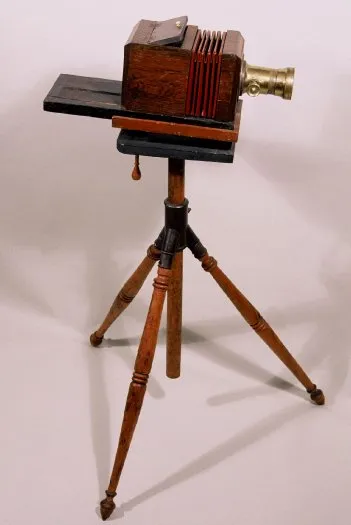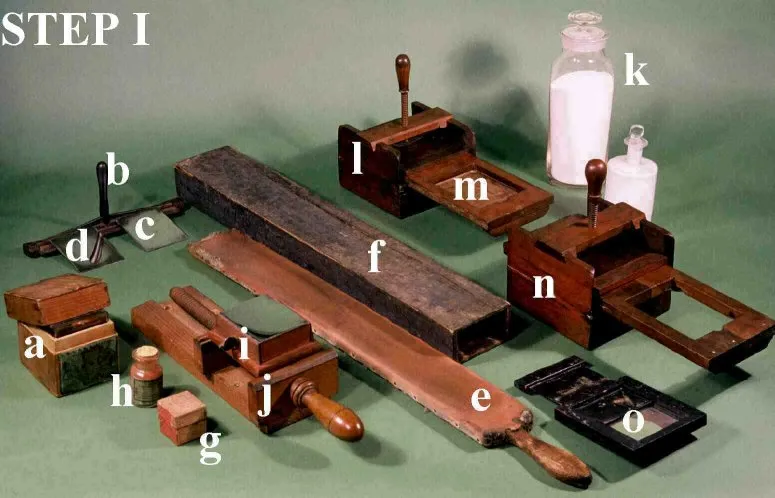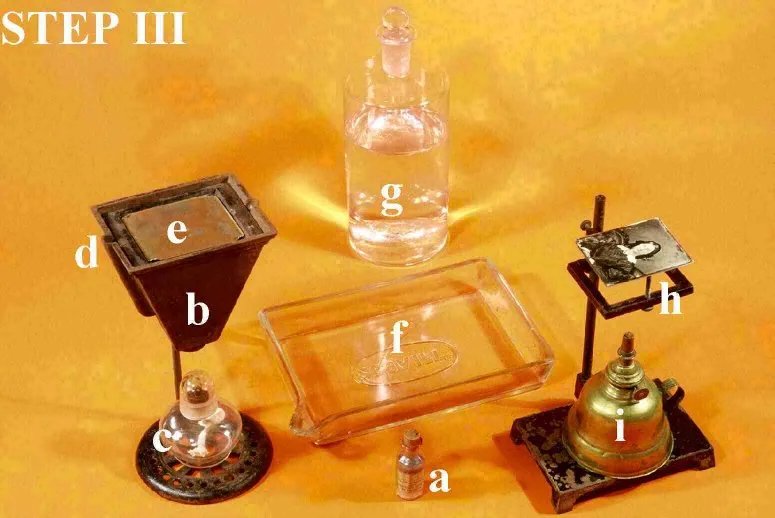Video: Making of a Daguerreotype, by Takashi AraiJapanese photographer and daguerreotypist Takashi Arai demonstrates the daguerreotype process at his studio. This video was made by Masafumi Ishikawa. The Making of a Daguerreotype, by Matthew R. R IsenburgThis illustrated brochure was prepared by Matthew Isenburg in conjunction with the exhibit Mirror with a Memory: The American Daguerreotype, on display at the Nelson-Atkins Museum of Art from October 13, 2001 through January 6, 2002, curated by Keith F. Davis.
Palmer and Longking Daguerreotype Camera ca. 1854 on Iron Center Tripod Copyright 2001 by Matthew R. Isenburg Hadlyme CT 06439-0189 Technical Assistance by Michael Robinson This brochure intends to serve two purposes: 1) Primarily, by guiding the reader through the process step by step, it may help the beginner develop an understanding of the complexities, pitfalls and mysteries of daguerreotypy. Warning: Do not use this brochure to actually attempt the making of a daguerreotype. The chemical procedure is far too dangerous for the incomplete information provided here. It deals with the physical manipulations and timing more than the chemistry of the process to give the reader a general feeling rather than a highly technical demonstration. Through review, using pieces only contemporary to the period, the advanced observer may develop a better understanding of how the craft affected the art. Thus, this pictorial instruction manual is offered for step by step making of a daguerreotype, utilizing only the finest examples of vintage equipment from the 1840s and the 1850s. 2) Through the photographs and information presented in this brochure, the reader will be able to identify and perhaps even rescue early equipment that might otherwise have been lost or forgotten. The very tools used for creating daguerreotypes are sculptural art in themselves and should be preserved and cherished along with the fascinating images they helped create. THE PROCESS It can be divided into many steps. In the interest of simplicity, both in this brochure and for display purposes, we chose to use five basic steps.
STEP I: PREPARING THE PLATE (20 to 25 minutes) By far the most time consuming and labor intensive of the five-step process. 1) Remove a plate from the plate box (a). 2) If not pre-crimped in manufacture, use plate bender (b) to turn down edges. This takes less than a minute. Perfectly flat plates (c) were produced in the early years. Later, they were pre-bent at the edges (d) to aid insertion in a plate vice (i). 3) Remove buffing stick (e) from storage or warming box (f). Only one shown in this illustration, but each polishing agent gets its own buffer. 4) Vigorously scour the crimped plate (d) with powdered rotten stone (not illustrated) to remove surface imperfections. 5) Rub chalk rouge (g) on deerskin side of buffing stick (e). 6) Much more common was powdered rouge (h). Sprinkle on buffing stick and rub powder into surface of the hide (e). 7) Install plate in Benedict’s plate holder (i), one of many gadgets sold commercially for securing the plate while buffing. 8) The entire assembly is clamped onto a wooden table vise (j). The vise is fastened to the table or bench. Now polish or buff the plate (always in the horizontal direction of what will be the finished image) for about 20 minutes to get a perfect mirror finish. The use of a treadle driven buffing wheel could measurably shorten the time of this step. 9) Lime from these bottles (k) is used to bed or cradle the bromine in the bottom of the glass tray which is inside the second coating box (n). 10) Insert buffed plate (m), face down in the sliding cover which is double the length of the box, and slide the plate into position over box containing iodine (l). When the plate turns light yellow, (usually about 15 to 25 seconds) remove from this box. The iodine stays good for years when kept in its sealed coating box so it is always ready to be used. 11) Move the plate (m) to the bromine box (n) and slide into position for approximately 5 to 10 seconds till the plate turns rose colored. When this takes over 15 seconds, the bromine (or quick stuff) has weakened and a pinch more should be added to freshen up the existing chemical. It will then stay potent for months. 12) Now in darkness, return plate to the iodine box (l) for a few seconds. This completes the coating, and you now have a properly sensitized plate. 13) Insert polished and sensitized plate in a plateholder (o) and close dark-slide, (shown partially open in this illustration). 14) All polishing except for the quick final buff of the plate with lampblack (not illustrated) is done in advance so the sitter can enter the studio and receive a finished likeness in less than thirty minutes!
STEP II: TAKING THE EXPOSURE (2 to 8 minutes) 1) Place the camera (a) on a tripod, (see Illustration Page 1). 2) Open trap doors (b) and (c) on top of camera . 3) Remove lens cap (d) from front of lens (e). 4) Insert the ground viewing glass (f) in open slot on camera top. 5) Focus lens (e) and compose your subject in its frame until you are satisfied. This usually takes more time than the actual exposure. Lightly replace lens cap (d). 6) Remove the viewing glass (f) from camera (a) and replace with the loaded plateholder (g) with dark-slide (h) in down position. (Though in the illustrated detail of this layout, an extra plateholder (g&h) is displayed partially drawn up in order to show the polished and sensitized daguerreotype plate’s position (i) within the plateholder (g). 7) With the plateholder in the camera, pull up the dark-slide as far as possible (h2), then remove and replace the lens cap (d), using it as the shutter. Normally indoors with good light this takes from ten to twenty seconds though most operators advertised much quicker exposure times to lure the gullable. If the advertising were to be believed, there would have been no need for headstands (see Illustration, Item 4). 8) Drop the dark-slide (h2) to secure the exposed plate from any further light and remove the plateholder from the camera.
STEP III: DEVELOPING, FIXING AND GILDING THE DAGUERREOTYPE (6 to 10 minutes) 1) Pour a small amount of mercury (a) into the cast iron fuming box (b). 2) In a vented dark room, light glass alcohol lamp (c). 3) Center the lamp on cast iron base under the bottom tip of inverted pyramid, slip thermometer (not illustrated) into the side slot (d) and heat mercury to approximately 175 degrees Fahrenheit. 4) With plate (e) face down on the heated fuming box (b), the image will develop by exposure to the fumes. This is where experience is necessary, since only trial and error can tell you when the plate is ready. In general this usually takes from 2 to 3 minutes. 5) In the glass tray (f) filled with hypo-sulfate, immerse plate face-up to arrest further chemical action. (This removes all the remaining light-sensitive chemicals). 6) Pour distilled water from bottle (g) over plate a few times in another tray to further remove unwanted chemicals. 7) Place plate (j) on gilding stand (h) and adjust screws to level the image so gold chloride won’t run off the plate when applied. This is more important with larger plates, since smaller plates can be leveled quite easily using hand pliers to grasp plate by its corner with no run off of liquid. 8) Light the Holmes Booth and Haydens brass spirit lamp (i) and gently pour on the gold chloride, which when heated, bonds to the silver image. This hardens the surface of the image (j) and makes it richer in tone.
STEP IV: HAND COLORING THE IMAGE This step is optional. (2 to 10 minutes) 1) Open the coloring box and choose the appropriate bottles of finely powdered colors (a). 2) Install on palette (b) as needed. 3) To mix colors use the white fabric interior of lid (c). 4) With a fine brush (d), sparingly stipple the dry color directly on the developed plate. Use squeeze bulb (not illustrated) to remove excess pigment. A soft brush or cotton can be used to soften and blend the color applied to the cheeks. Some suggest breathing gently on the plate to make the dry powders adhere more readily. 5) The most common request is for tinting of the woman’s lips and cheeks. There are two extra cylindrical wood containers of powdered colors labeled "CARMINE" and "LADIES FLESH COLOR" (e) since they are in such high demand. 6) The two small enamel dishes (f) are for applying liquid gold or silver on the plate to accentuate jewelry, gold objects or gold braid on clothing. 7) A small prick or hand-punch tapped directly on the plate could be further used to accent diamonds, pearls or other jewelry. (Not illustrated) 8) Sixth plate daguerreotype (g), maker unknown, ca. 1853 of a man tinting an image using an outfit identical to the one in the illustration. To its right is shown a tinted sixth plate daguerreotype (h), maker unknown, ca. 1853 of an actor, wearing a red and grey tunic adorned with gilded trimmings showing an example of both hand coloring and gilding.
STEP V: PROTECTING, PRESERVING AND PRESENTING THE FINISHED PRODUCT (2 to 4 minutes) 1) Wafer a brass mat (b) between the image (a) and a glass rectangle of the same size (c) as shown in the exploded daguerreotype on left. 2) Remove proper amount of sealing paper from roll (d1). Apply glue to one side of sealing paper (d) and place around edge of the glass, then fold backwards and press on back of plate. It is now a sealed daguerreotype. 3) Remove frame-like mat preserver from open stack (e1) or one half gross box (e2) and encase and wrap around the sandwiched layers of image, mat, glass and seal. Mat preservers first came into common usage ca. 1847. 4) From rear it should now look like (f). From front it should look like (g). 5) Insert in case (h) and present to recipient. Please note that usually the velvet or satin is on the left (i) and the image is inserted on the right (j). |







